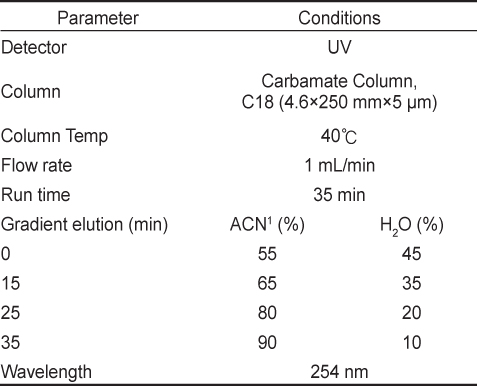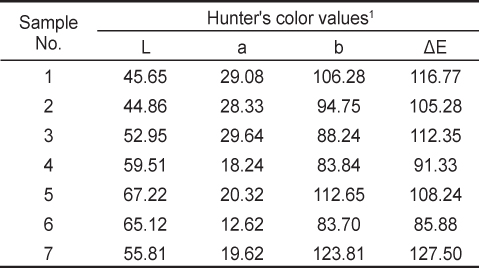



This study investigated the quality of seven commercial salted and fermented sand lance Ammodytes personatus sauces by measuring their chemical compositions, bacteria concentrations, and biogenic amine contents. The sauces had a 63.97-67.32% (mean: 65.72%) moisture content, 23.16-24.03% (mean: 23.60%) salinity, 5.51-6.14 (mean: 5.81) pH, 164.76-217.98 mg/100 g (mean: 182.97 mg/100 g) volatile basic nitrogen, 0.94-1.42% (mean: 1.24%) total nitrogen, and 673.77-791.86 mg/100 g (mean: 720.76 mg/100 g) amino nitrogen content. Viable cell counts ranged from 1.2×101 to 2.9×102 CFU/mL, and number of biogenic amine-forming bacteria was very low or not detected. Overall, the tested samples had average levels of histamine of 301.02 mg/kg, cadaverine of 29.78 mg/kg, tyramine of 199.21 mg/kg, putrescine of 183.00 mg/kg, and tyramine of 13.01 mg/kg. This strongly suggests that it is necessary to monitor the biogenic amine contents of commercial salted and fermented sand lance sauces carefully to ensure consumer health.
우리나라의 대표적인 수산 발효 식품인 액젓은 어류, 갑각류, 연체류, 극피류 등의 전체 또는 일부분을 주원료로 하여 식염을 가하여 발효 숙성한 후 여과하거나 분리한 액 또는 이에 젓갈을 여과하거나 분리하고 남은 것을 재발효 및 숙성시킨 후 여과하거나 분리한 액을 혼합한 것을 말한다(KMFDS, 2015). 액젓의 원료 어종으로는 멸치, 까나리, 정어리, 갈치, 밴댕이, 참치, 새우 등이 쓰이며 어체에 20-30% 정도의 식염을 가하여 15-25℃의 상온에서 1~2년 이상 장기간 숙성 후 여과한다. 식품공전에 따른 액젓 품질에 관한 규격은 총질소(액젓 1.0% 이상, 조미액젓 0.5% 이상), 대장균군 음성 및 타르색소 불검출로 규정되어 있다(KMFDS, 2015). 또한 수산전통식품 품목별 품질 기준은 액젓의 품질기준으로 색택(고유의 색깔을 띠고 변색이 없어야 한다), 향미(고유의 향미를 가지고 이취가 없어야 한다), 협잡물(토사 및 기타 협잡물이 없어야 한다), 수분(70% 이하), 염분(23% 이하), 전질소(1.0% 이상) 등에 관한 규정이 설정되어 있다(NFQS, 2013).
액젓은 어류, 패류, 어류의 내장 등에 고농도의 염을 가하여 부패균의 증식을 억제하고 어패류 자체의 효소와 미생물 작용으로 발효 숙성한 후 여과하여 만든 식품으로 독특한 맛과 풍미가 있으나 비위생적인 환경에 노출되어 유해미생물이 증식할 우려가 있어 액젓 발효에 부정적인 영향을 미칠 수 있다. 가장 대표적인 화학적 위해 요인인 biogenic amines은 단백질을 함유한 식품이 부패하거나 발효과정에서 유리아미노산이 미생물의 탈탄산 작용으로 생성되는 물질로 체내에서 직·간접적으로 신경전달물질로 작용하고 혈압조절 및 혈류 등의 심혈관에도 영향을 미치며(Lovenberg, 1973), biogenic amines이 함유된 식품을 다량 섭취하였을 경우 신진대사에 이상이 생기고, 두통, 메스꺼움, 오한, 경련 등 건강에 해를 끼칠 우려가 있다(Joosten and olieman, 1986; Shalaby, 1996). 국내 유통 발효식품에서 가장 빈번하게 검출되는 biogenic amines의 종류로는 histamine, putrescine, cadaverine, tyramine, spermine, spermidine 및 tryptamine 등이다(Cho et al., 2006). Biogenic amines 중 가장 널리 알려져 있는 histamine은 고등어, 꽁치, 정어리, 다랑어류 등의 어종을 비위생적으로 처리하여 부패가 발생하면 ‘고등어 중독증’이 유발하게 된다(Taylor, 1986). 그러나 histamine에 의한 식중독은 일반적인 식품 단백질 알레르기와 비슷하여 그 발생빈도가 잘 알려져 있지는 않다(Hungerford, 2010). 식품의 안전성 측면에서 biogenic amines의 분포 및 함량 조사는 매우 중요하나 우리나라에서는 냉동어류, 염장어류, 통조림, 건조/절단 등 단순 처리한 식품의 경우 histamine 함량은 200 mg/kg 이하로 설정되어 있다(KMFDS, 2015). 또한 식품 중 tyramine과 phenylethylamine의 경우 각각 100-800 mg/kg 및 30 mg/kg 이하로 권고하고 있지만(Ten Brink et al., 1990), 우리나라는 이들 아민에 대한 기준 또는 규격은 설정되어 있지 않다. 따라서 본 논문은 시판용 까나리액젓의 이화학적, 미생물학적 및 biogenic amines 함량 분석을 통하여 국내 까나리액젓의 품질평가를 위한 기초자료로 제공하고자 한다.
실험에 사용한 까나리액젓은 대형마트 및 도매시장 등에서 판매하고 있는 까나리액젓 7종[B사(경기 인천), C사(경기 안성), D사(충남 천안), G사(전북 부안), H사(충남 논산), K사(충남 홍성), N사(충남 논산)] 제품을 구입하여 냉장고에 보관하면서 분석에 사용하였다. Biogenic amine 표준품인 cadaverine, histamine (97%), putrescine, spermidine (98%), spermine (97%), tryptamine (98%), tyramine (99%)과 내부표준물질로 사용되는 1,7-diaminoheptane (I.S.) 및 유도체 시약 dansyl chloride는 Sigma-Aldrich (Switzerland) 제품을, acetonitrile은 HPLC 급을 사용하였으며, ether 등은 특급 시약을 사용하였다.
수분함량은 105℃에서 상압 가열 건조법(AOAC, 1995), 휘발성염기질소의 함량은 Conway unit를 사용하는 미량확산법(Ministry of Social Welfare of Japan, 1960), 식염 함량은 Mohr법(AOAC, 1995), 총질소 함량은 semi-micro Kjeldahl법(AOAC, 1995), 아미노산성질소 함량은 Formol적정법(Kohara, 1982), pH는 pH meter (UB-10, Denver Instrument Co., Germany)로 상온에서 측정하였다.
색도는 색차계(JC 801, Color Technosystem Co., Ltd., Tokyo, Japan)로 측정하여 Hunter color system에 의한 L 값(명도), a 값(적색도), b 값(황색도)으로 나타내었다. 이때 사용한 표준 백판의 L값은 92.017, a 값은 0.032, b 값은 3.134 이었다.
>
생균수, 대장균군 및 biogenic amines 생성균의 측정
생균수는 Standard Methods for the Examination of Water and Wastewater (APHA, 1984)의 방법에 따라 Standard plate count agar (Difco, USA)를 사용하여 35±0.5℃에서 48시간 배양 후 형성된 집락수로 계산하였다. 대장균군 측정은 대장균군 건조필름배지(3M™ Petrifilm™ Coliform Count plates; 3M, St. Paul, MN)를 이용하였다. 시료를 연속적으로 희석한 후 희석액 1 mL를 각각의 건조필름배지 중앙에 접종한 뒤 건조필름배지를 35±0.5℃의 배양기에서 24시간 배양 후 액화 현상이 없고 붉은색 colony의 gas가 생성된 집락수를 측정하였다. Biogenic amines 생성 균수는 biogenic amine의 전구체인 아미노산을 최종농도 2%가 되도록 첨가하여 제조한 배지[tryptone (0.5%), yeast extract (0.5%), sodium chloride (0.5%), glucose (0.1%), tween 80 (0.05%), MgSO4·7H2O (0.02%), CaCO3 (0.01%), MnSO4·4H2O (0.005%), FeSO4·7H2O (0.004%), bromocresol purple (0.006%), amino acid (2%) and agar (2%)]를 사용하여 35±0.5℃에서 48시간 배양 후 보라색 환을 띄는 집락을 계수하였다(Zaman et al., 2011).
시료 중 biogenic amines 함량 측정은 일본위생시험법의 불휘발성부패아민 분석법을 바탕으로 하는 식품공전의 수산물에 대한 규격(KMFDS, 2015)에 준하여 실시하였다. 시료 1.0 mL에 0.1N HCl을 가하여 50 mL로 정용하여 시험용액으로 사용하였다. 시료용액 1.0 mL를 시험관에 취한 후 100 μg/mL의 내부표준물질(1,7-diaminoheptane) 100 μL를 가하고 포화탄산나트륨용액 0.5 mL와 1% dansyl chloride acetone 용액 0.8 mL를 가하여 혼합한 후 마개를 하여 45℃에서 1시간 유도체화 하였다. 유도체화한 표준용액 및 시험용액에 10% proline 용액 0.5 mL 및 ether 5 mL를 가하여 10분간 진탕하고 상층액을 취하여 질소 농축한 뒤 acetonitrile 1 mL를 가하여 녹이고 0.45 μm로 여과한 것을 HPLC system (YL 9100, YoungLin Instrument Co., Ltd., Korea)으로 분석하였으며, 분석 조건은 Table 1과 같다.

Instrument condition for HPLC analysis of biogenic amine in commercial salted and fermented sand lance sauces Ammodytes personatus
실험에 사용한 7종 까나리액젓의 수분, 염도, pH, VBN, 총 질소, 및 아미노산성질소함량은 시료당 3회 측정하여 그 평균값을 Table 2에 나타내었다. 7종 까나리액젓의 수분은 63.97-67.32% (평균 65.72%), 염도는 23.16-24.03% (평균23.60%), pH는 5.51-6.14 (평균 5.81), VBN은 164.76-217.98 mg/100 g (평균 182.97 mg/100 g), 총질소는 0.94-1.42% (평균 1.24%) 및 아미노산성질소는 673.77-791.86 mg/100 g (평균 720.76 mg/100 g) 수준으로 측정되었으며 제품에 따른 이화학성분의 차이는 전체적으로 크지 않았다. 수분함량은 수산전통식품품목별 품질 기준인 70% 이하를 모든 시료에서 만족하는 수준인 반면 염도는 기준치인 23% 이하를 모두 초과하는 것으로 측정되었으며, 아미노산성질소 함량은 KS 산업규격기준인 600 mg/100 g 이상의 조건에 모든 시료가 적합한 것으로 측정되었다. 또한 총질소는 1종을 제외한 나머지6종은 식품공전 및 수산전통식품품목별 품질 기준인 1%을 초과하는 것으로 측정되었다. 최근에 보고된 Kim et al. (2011)의 10종 까나리액젓 이화학성분은 수분 67.87-69.93%, VBN 105.50-258.93 mg/100 g, 염도 22.46-26.11%, 총질소 0.98-2.05%, 아미노산성질소 878.20-1, 430.09 mg/100 g, pH 4.85-5.68 이였다고 보고 하였는바 본 실험결과와 비교해 보면 7종 까나리액젓은 수분, 염도, 총질소 및 아미노산성질소 함량은 조금 낮은 반면 pH 및 VBN 함량은 조금 높은 것으로 파악되었다.

The contents of moisture, salinity, pH, VBN, total nitrogen and amino nitrogen in commercial salted and fermented sand lance sauces Ammodytes personatus
액젓의 색도는 발효과정에서 생성되는 유리아미노산과 환원당에 의한 Maillard 반응의 중간산물인 melanoidin이 생성되어 갈색이 증가하며, 액젓은 질소화합물의 대부분이 유리아미노산과 펩티드로 구성되어 있어 갈색이 증가하게 된다(Lee et al., 1997; Van Boekel, 1998; Wanakhachornkrai and Lertsiri, 2003). 7종 까나리액젓의 색도는 육안으로도 구별할 수 있을 정도로 제품에 따라 차이가 있기에 색도 차이를 측정할 필요성이 대두되었으며 측정한 결과는 Table 3에 제시하였다. 7종 까나리액젓의 명도(L)는 44.86-67.22 (평균 55.87), 황색도(a)는 12.62-29.64 (평균 22.55), 적색도(b)는 83.70-123.81 (평균 99.04), ΔE값은 85.88-116.77 (평균 106.76)로 측정되었으며 이는 기존의 국내산 시판 까나리액젓의 색도에 관한 연구결과(ΔE값이 83.30-89.33)보다 다소 높게 측정되었다(Cho et al., 1999). 제품에 따라 색도에 차이가 있는 이유는 주원료인 까나리 이외에 곤쟁이 등의 기타 어류를 혼합하여 발효하기 때문에 기타 어류 종류 및 함량 차이, 발효 기간 및 발효 조건 차이 등의 원인으로 melanoidin 생성량이 달라짐에 따라 제품의 색도 차이가 발생한 것으로 판단되므로 추후 색도와 melanoidin 함량과의 상관관계에 대한 규명은 필요하다고 판단된다.
[Table 3.] Color values of commercial salted and fermented sand lance sauces Ammodytes personatus

Color values of commercial salted and fermented sand lance sauces Ammodytes personatus
>
생균수, 대장균군 및 biogenic amines 생성균
까나리액젓의 생균수, 대장균군 및 biogenic amines 생성균 을 측정한 결과는 Table 4에 나타내었다. 까나리액젓에 존재하는 생균수는 1.2×101 ~ 2.9×102 CFU/mL 수준으로 매우 낮은 균수이며, 대장균군은 모든 시료에서 검출되지 않았다. 시료 및 아민 종류에 관계없이 biogenic amines 생성균은 검출되지 않거나 존재하더라도 매우 낮은 수준인 것으로 파악되었다. 생균수와 biogenic amines 생성균이 매우 낮은 수준인 것은 까나리액젓 제조공정 중의 살균 및 여과과정에서의 사멸 가능성 보다는 고농도의 염 상태에서 장기간 숙성하는 과정에서 초내 염성균을 제외한 세균은 삼투압에 의한 사멸이 원인이 되어 결과적으로 까나리액젓 중의 미생물 농도는 매우 낮은 것으로 판단된다. 실험에 사용한 7종의 까나리액젓은 HACCP기준에 의해 살균 처리한 제품과 살균하지 않은 제품의 생균수 차이가 크지 않다는 점에서 고농도 염에 의한 미생물 사멸 가능성은 높다고 판단된다. 따라서 추후 시판 까나리액젓에 존재하는 미생물의 동정 및 다양성 분석은 까나리액젓의 발효과정중의 미생물 상 변화 및 발효에 관여하는 미생물을 이해하는데 도움이 될 것으로 판단된다.

Biogenic amines formation bacteria, viable cell and coliform bacteria in commercial salted and fermented sand lance sauces Ammodytes personatus
까나리액젓의 biogenic amines 함량을 측정한 결과는 Table 5에 나타내었다. 기존의 까나리액젓의 연구에서 많이 검출된 아민인 cadaverine, histamine, putrescine, spermidine, spermine, tryptamine 및 tyramine 등 7종의 아민을 정량 하였다(Cho et al., 2006; Moon et al., 2010; Kim et al., 2011). 7종의 시판 까나리액젓에 존재하는 histamine은 240.8-410.4 mg/kg (평균 301.02 mg/kg), putrescine은 73.61-500.23 mg/kg (평균 183.00 mg/kg), cadaverine은 10.97-65.67 mg/kg (29.78 mg/kg), tryptamine은 9.42-18.19 mg/kg (평균 13.01 mg/kg), tyramine은 88.26-348.92 mg/kg (평균 199.21 mg/kg)인 것으로 분석되었으나 spermidine과 spermine은 모든 시료에서 검출되지 않았다. 7종 까나리액젓의 histamine농도는 EU 와 국제식품규격위원회(CODEX)의 기준인 200 mg/kg을 초과하였으며, 400 mg/kg을 초과하는 시료도 1건 검출되었으나 이 결과는 기존 보고보다는 낮은 농도에 해당된다(Moon et al., 2010; Kim et al., 2011). Putrescine은 시료에 따라 최대 6.8배 차이가 있어 다른 아민에 비해 농도차가 가장 심한 편이나 평균값은 기존의 연구결과와 유사하였다(Cho et al., 2006; Kim et al., 2011). Cadaverine은 시료에 따라 최대 약 6배 정도의 차이를 보이며, 기존의 결과와 비교해 보면 평균 약 1.4배 높거나(Kim et al., 2011), 5.6배 낮은 것으로(Cho et al., 2006) 파악되었는데 이는 원료, 발효 조건 및 발효 기간 등의 차이에 의한 결과라고 판단될 뿐 정확한 원인에 대해서는 추후 분석이 필요하다고 판단된다. Tryptamine은 2개 시료에서만 검출되고 나머지 5개 시료에서는 검출되지 않았는데 기존 연구결과(Cho et al., 2006)에 비해 약 9배 이상 낮은 농도인 것으로 파악되었다. 또한 tyramine 은 기존 결과에 비해 낮은 결과로 측정되었다(Moon et al., 2010; Kim et al., 2011). 본 연구에서 검출되지 않은 spermidine과 spermine은 기존의 보고에서도 검출되지 않았거나(Moon et al., 2010), spermine은 3.32-8.35 mg/kg의 낮은 수준으로 검출되었다는 보고가 있다(Kim et al., 2011).

Biogenic amine contents in commercial salted and fermented sand lance sauces Ammodytes personatus
본 연구에서 국내 시판용 7종 까나리액젓의 이화학적 성분 및 미생물을 분석한 결과 제품에 따라 차이는 다소 있었으나 식품공전의 액젓 품질 규격 및 수산전통식품의 액젓 품질기준에는 대체로 만족하는 수준으로 파악되었다. 안전성 지표인 biogenic amines 함량은 제품 및 아민 종류에 따라 차이가 컸으며, 특히 histamine, putrescine, tryptamine 함량은 대체로 높은 것으로 파악되었다. 업계의 자구노력, 학회, 포럼 및 분석법 교육 등을 통하여 발효식품 중 biogenic amines의 저감화를 위해 노력은 하고 있지만 아직 뚜렷한 개선점은 부족한 실정이다. 따라서 우리나라 발효식품 및 액젓의 안전성 확보, 선진화 및 세계화를 위해서는 위생적인 환경에서 제조해야 함과 동시에 품질 개선을 위한 노력과 연구도 활발히 이루어져야 한다고 사료된다.




